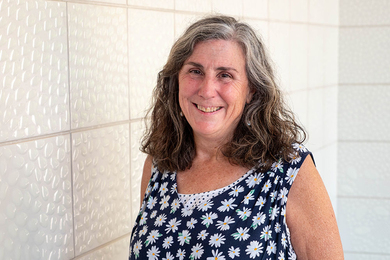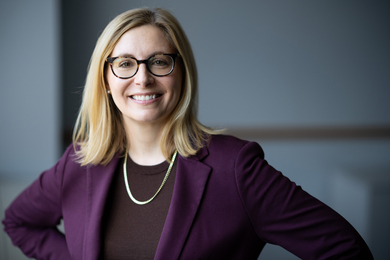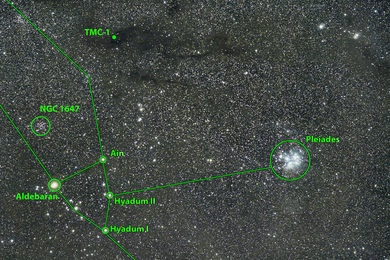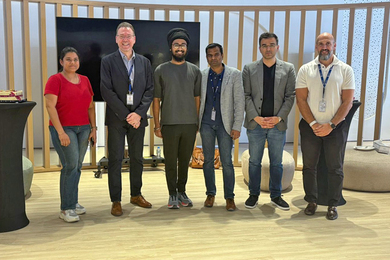Traditionally, dentists have made dental impressions by having patients bite down on a moldable silicone material. Such impressions, however, can be messy and uncomfortable, and sometimes inaccurate.
In the early 2000s, a group of researchers from MIT and business students from Harvard University began working to commercialize a novel handheld scanner — with MIT roots — that could digitally capture three-dimensional images of the inside of a patient’s mouth.
Allowing fast, real-time digital dental impressions, this innovation was developed by Brontes Technologies, a startup co-founded by the team: MIT professor Douglas Hart, former MIT postdoc János Rohály, and two Harvard Business School graduate students.
After just three years, manufacturing giant 3M acquired Brontes and all its technology for $95 million — one of the largest-ever acquisitions of a dental technology, Hart says.
In 2008, 3M launched the team’s invention, dubbed the Lava Chairside Oral Scanner (or Lava COS), which has now been sold to thousands of dentists worldwide. Last year, 3M announced that the scanner had surpassed 100,000 clinical uses.
As a first-time entrepreneur with Brontes, Hart says that ushering an innovation from the lab to the market — and then selling it for millions — is a somewhat uncommon path for researchers. But thanks to numerous factors, including MIT’s entrepreneurial ecosystem — which, Hart says, encourages commercialization of innovations — “now every dentist has heard of the scanner, it’s all over the world.”
Brontes’ Harvard co-founders were CEO Eric Paley and chief operating officer Micah Rosenbloom. Additional MIT inventors of the technology were Rohály (Brontes’ chief scientist), and then-graduate students Federico Frigerio SM ’97, PhD ’06 and Sheng Tan SM ’02, PhD ’05.
A new way of imaging
The core of the Lava COS technology originated in the early 2000s, when Hart was working on seeding fluids with particles and scanning them at high speeds with a pulsing laser — a process known as particle imaging velocimetry.
Developing the technology under a grant from the Industrial Technology Research Institute (ITRI) in Taiwan, Hart and his team took a research detour and invented a novel, video-rate 3-D scanner that used a single camera lens and a timed rotating aperture. They coordinated that hardware with image-processing algorithms and modeling software to create fast 3-D images in real-time.
“That started a whole new way of thinking about imaging,” says Hart, a professor of mechanical engineering. “You’re not just using a camera passively, it’s an interaction between the camera and software talking to each other. I was so convinced this was a great idea, I dropped the contract from ITRI and refocused.”
Assembling a team of MIT researchers, Hart set out to commercialize the innovation. Originally, while working with ITRI, the team wanted to use their technology to superimpose actors’ facial expressions onto animated characters. (This actually earned them a spot presenting at the 2001 SIGGRAPH conference for computer graphics, held in Los Angeles — with a booth between those of Pixar and Dreamworks.)
Evolution to dentistry
It wouldn’t be until a couple of years later that Hart would meet Rosenbloom and Paley while entering MIT’s $50K (now $100K) entrepreneurship competition. The two jumped on board and, eventually, steered the technology toward dentistry under Brontes — named after a Cyclops of Greek mythology (in reference to their single-lens scanner).
For the next few years, Brontes developed the technology out of its headquarters in Lexington, Mass. After many complications — including bulky prototypes and overheating scanners — the company finalized its device.
Today, the Lava COS — newly minted as the 3M True Definition Scanner — features a “wand,” about the shape and size of an electric toothbrush. Dentists maneuver the wand around the inside of a patient’s mouth, like a handpiece; the wand takes dozens of photos of the teeth and feeds the 3-D data, in real-time, to a touch screen for the dentists’ use. According to 3M, it enhances the speed, ease and accuracy of dental impressions that are used to design and produce various types of dental restorations.
“It’s evolved so much,” says Hart, who briefly served as Brontes’ chief technology officer, then as an advisor.
In fact, Hart says he owes the company’s success, in part, to allowing the technology to evolve. “Universities sometimes leave things at a very crude level, because we’re researchers,” he says. “And I think good companies realize that the technology needs to evolve into something else, something better. And Brontes was very much run that way.”
Entrepreneurship: a way to make an impact
But Hart attributes some of the company’s early success to MIT. Seed funding, for instance, came from a grant from MIT’s Deshpande Center for Technological Innovation — part of the first round of Deshpande grants, and the largest given at the time. The company’s co-founders also earned funds as runner-ups in entrepreneurship competitions at MIT and Harvard Business School.
Hart also points to entrepreneurial mentors he met early on at MIT, such as Institute Professor Robert Langer — “an outstanding academic with an amazing record of entrepreneurship and innovation” — and the Deshpande Center’s then-director, Krisztina Holly.
“MIT was a different climate than I had seen before,” Hart says. “It has a model which allows innovation and entrepreneurship to flourish. I don’t think I could have done it without that guidance and support I received.”
Now Hart says he’s “hooked” on entrepreneurship. After selling Brontes, he co-founded Lantos Technology, which provides 3-D scans of the ear canal for custom-fit hearing devices, such as hearing aids and earphones. He also co-founded Glissade in Taiwan, which is working to develop a very low-cost dental scanner for less affluent markets.
“I view entrepreneurship as another way to make an impact,” Hart says. “Writing papers, doing research and presenting are all good ways, but entrepreneurship is another that’s viable and valiant. I don’t know of any better way to make an impact than improving the health of millions of people.”
In the early 2000s, a group of researchers from MIT and business students from Harvard University began working to commercialize a novel handheld scanner — with MIT roots — that could digitally capture three-dimensional images of the inside of a patient’s mouth.
Allowing fast, real-time digital dental impressions, this innovation was developed by Brontes Technologies, a startup co-founded by the team: MIT professor Douglas Hart, former MIT postdoc János Rohály, and two Harvard Business School graduate students.
After just three years, manufacturing giant 3M acquired Brontes and all its technology for $95 million — one of the largest-ever acquisitions of a dental technology, Hart says.
In 2008, 3M launched the team’s invention, dubbed the Lava Chairside Oral Scanner (or Lava COS), which has now been sold to thousands of dentists worldwide. Last year, 3M announced that the scanner had surpassed 100,000 clinical uses.
As a first-time entrepreneur with Brontes, Hart says that ushering an innovation from the lab to the market — and then selling it for millions — is a somewhat uncommon path for researchers. But thanks to numerous factors, including MIT’s entrepreneurial ecosystem — which, Hart says, encourages commercialization of innovations — “now every dentist has heard of the scanner, it’s all over the world.”
Brontes’ Harvard co-founders were CEO Eric Paley and chief operating officer Micah Rosenbloom. Additional MIT inventors of the technology were Rohály (Brontes’ chief scientist), and then-graduate students Federico Frigerio SM ’97, PhD ’06 and Sheng Tan SM ’02, PhD ’05.
A new way of imaging
The core of the Lava COS technology originated in the early 2000s, when Hart was working on seeding fluids with particles and scanning them at high speeds with a pulsing laser — a process known as particle imaging velocimetry.
Developing the technology under a grant from the Industrial Technology Research Institute (ITRI) in Taiwan, Hart and his team took a research detour and invented a novel, video-rate 3-D scanner that used a single camera lens and a timed rotating aperture. They coordinated that hardware with image-processing algorithms and modeling software to create fast 3-D images in real-time.
“That started a whole new way of thinking about imaging,” says Hart, a professor of mechanical engineering. “You’re not just using a camera passively, it’s an interaction between the camera and software talking to each other. I was so convinced this was a great idea, I dropped the contract from ITRI and refocused.”
Assembling a team of MIT researchers, Hart set out to commercialize the innovation. Originally, while working with ITRI, the team wanted to use their technology to superimpose actors’ facial expressions onto animated characters. (This actually earned them a spot presenting at the 2001 SIGGRAPH conference for computer graphics, held in Los Angeles — with a booth between those of Pixar and Dreamworks.)
Evolution to dentistry
It wouldn’t be until a couple of years later that Hart would meet Rosenbloom and Paley while entering MIT’s $50K (now $100K) entrepreneurship competition. The two jumped on board and, eventually, steered the technology toward dentistry under Brontes — named after a Cyclops of Greek mythology (in reference to their single-lens scanner).
For the next few years, Brontes developed the technology out of its headquarters in Lexington, Mass. After many complications — including bulky prototypes and overheating scanners — the company finalized its device.
Today, the Lava COS — newly minted as the 3M True Definition Scanner — features a “wand,” about the shape and size of an electric toothbrush. Dentists maneuver the wand around the inside of a patient’s mouth, like a handpiece; the wand takes dozens of photos of the teeth and feeds the 3-D data, in real-time, to a touch screen for the dentists’ use. According to 3M, it enhances the speed, ease and accuracy of dental impressions that are used to design and produce various types of dental restorations.
“It’s evolved so much,” says Hart, who briefly served as Brontes’ chief technology officer, then as an advisor.
In fact, Hart says he owes the company’s success, in part, to allowing the technology to evolve. “Universities sometimes leave things at a very crude level, because we’re researchers,” he says. “And I think good companies realize that the technology needs to evolve into something else, something better. And Brontes was very much run that way.”
Entrepreneurship: a way to make an impact
But Hart attributes some of the company’s early success to MIT. Seed funding, for instance, came from a grant from MIT’s Deshpande Center for Technological Innovation — part of the first round of Deshpande grants, and the largest given at the time. The company’s co-founders also earned funds as runner-ups in entrepreneurship competitions at MIT and Harvard Business School.
Hart also points to entrepreneurial mentors he met early on at MIT, such as Institute Professor Robert Langer — “an outstanding academic with an amazing record of entrepreneurship and innovation” — and the Deshpande Center’s then-director, Krisztina Holly.
“MIT was a different climate than I had seen before,” Hart says. “It has a model which allows innovation and entrepreneurship to flourish. I don’t think I could have done it without that guidance and support I received.”
Now Hart says he’s “hooked” on entrepreneurship. After selling Brontes, he co-founded Lantos Technology, which provides 3-D scans of the ear canal for custom-fit hearing devices, such as hearing aids and earphones. He also co-founded Glissade in Taiwan, which is working to develop a very low-cost dental scanner for less affluent markets.
“I view entrepreneurship as another way to make an impact,” Hart says. “Writing papers, doing research and presenting are all good ways, but entrepreneurship is another that’s viable and valiant. I don’t know of any better way to make an impact than improving the health of millions of people.”







